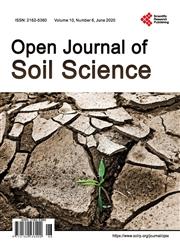Comparison and Estimation of Four Infiltration Models
引用次数: 7
Abstract
Infiltration is an important component of the hydrological cycle. It provides soil moisture in the vadose zone to support plant growth. This study was conducted to compare the validity of four infiltration models with measured values from the double ring infiltrometer. The parameters of the four models compared were estimated using the linear regression analysis. The C.C was used to show the performance of the predictability of the models. The RMSE, MAE and MBE were employed to check the anomalies between the predicted and the observed values. The results showed that, average values of the C.C ranged from 0.9294 - 0.9852. The average values of the RMSE were 4.0033, −17.489, 11.2400 and 49.8448; MAE were 3.1341, 15.9802, 10.6525, and 61.4736; and MBE were 0.0786, 9.5755, 0.0007 and 47.0204 for Philip, Horton, Green Ampt and Kostiakov respectively for the wetland soils. Statistical results also from the Fisher’s multiple comparison test show that the mean infiltration rate estimated from the Green Ampt’s, Philip’s and Horton’s model was not significantly different (p > 0.05) from the observed. The results indicated that the Kostiakov’s model had the highest deviations as it overestimated the measured data in all the plots. Comparison of the statistical parameters C.C, RMSE, MAE, and MBE for the four models indicates that the Philip’s model agreed well with the measured data and therefore, performed better than the Green Ampt’s, Horton’s and Kostiakov’s models respectively in that order for Besease wetland soils. Estimation of infiltration rate by the Philip’s model is important in the design of irrigation schemes and scheduling. Therefore, in the absence of measured infiltration data, the Philip’s model could be used to produce infiltration information for inland valley bottom soils that exhibit similar characteristic as Besease wetland soils.四种入渗模式的比较与估算
入渗是水循环的重要组成部分。它提供了土壤水分在渗透区,以支持植物生长。本研究比较了四种入渗模型与双环式入渗仪测量值的有效性。采用线性回归分析对四种模型的参数进行估计。cc用于显示模型的可预测性的性能。采用RMSE、MAE和MBE对预测值与实测值的异常进行检验。结果表明,C.C的平均值为0.9294 ~ 0.9852。RMSE均值分别为4.0033、- 17.489、11.2400和49.8448;MAE分别为3.1341、15.9802、10.6525、61.4736;Philip、Horton、Green Ampt和Kostiakov湿地土壤的MBE分别为0.0786、9.5755、0.0007和47.0204。Fisher多重比较检验的统计结果也表明,Green Ampt’s、Philip’s和Horton’s模型估计的平均入渗速率与观测值无显著差异(p > 0.05)。结果表明,Kostiakov模型在所有图中都高估了实测数据,偏差最大。四种模型的统计参数C.C、RMSE、MAE和MBE的比较表明,Philip模型与实测数据吻合较好,因此在Besease湿地土壤中分别优于Green Ampt、Horton和Kostiakov模型。利用菲利普模型估算入渗速率对灌溉方案的设计和调度具有重要意义。因此,在没有实测入渗数据的情况下,Philip’s模型可以用于产生与Besease湿地土壤具有相似特征的内陆河谷底部土壤的入渗信息。
本文章由计算机程序翻译,如有差异,请以英文原文为准。
求助全文
约1分钟内获得全文
求助全文

 求助内容:
求助内容: 应助结果提醒方式:
应助结果提醒方式:


